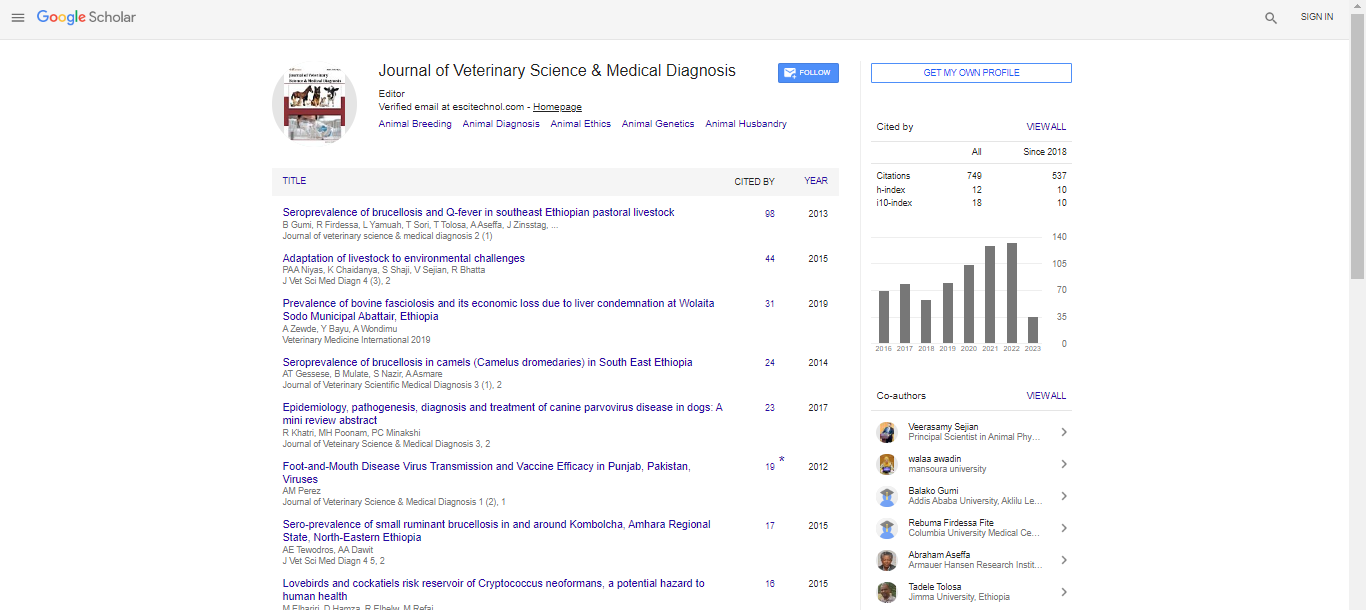Editorial, J Vet Sci Med Diagn Vol: 0 Issue: 0
Phosphoproteomic Insights of Meat Quality, Protein Carbonylation and Protein Cross-Linking
Christopher Hartman* Department of Animal Science, University of Bath, Claverton Down, Bath, BA2 7AY, United Kingdom
*Corresponding author: Christopher Hartman, Department of Animal Science, University of Bath, Claverton Down, Bath, BA2 7AY, United Kingdom, E-mail: chrishart@bath.ac.uk
Received date: 02 October, 2021; Accepted date: 23 October, 2021; Published date: 30 October, 2021
Abstract
In meat creation frameworks, sheep makers and scientists principally center on expanding butcher weight (SW). It is notable that even a little expansion in SW might bring about expanded efficiency proportion and makes more choices to control these raising or swelling frameworks, which are enhanced with field or great quality roughage and business concentrate feed. Likewise, a control that expands meat quality and amount with an intend to build usefulness and wages, thinking about buyer acknowledgment, is alluring in the meat creation frameworks. Crossbreeding practices of native ewes with meat-type breeds and serious sheep raising in the wake of weaning are the most widely recognized practices to expand SW . As recently detailed, the age and weight of sheep at the butchering time frame are the primary factors that influence the cadaver as far as meat quality and amount. As of late, there has been an extraordinary interest in lean remains among the shoppers with the suggestion of logical investigations and nourishing rules. The sum and site of fat in the corpse and additionally remains cuts and meat shading assume a significant part in affecting client choices when buying new meat.
Keywords: Meat Quality, Phosphoproteomic Insights. Carbonylation, Protein Cross- Linking
Introduction
In meat creation frameworks, sheep makers and scientists principally center on expanding butcher weight (SW). It is notable that even a little expansion in SW might bring about expanded efficiency proportion and makes more choices to control these raising or swelling frameworks, which are enhanced with field or great quality roughage and business concentrate feed. Likewise, a control that expands meat quality and amount with an intend to build usefulness and wages, thinking about buyer acknowledgment, is alluring in the meat creation frameworks. Crossbreeding practices of native ewes with meat-type breeds and serious sheep raising in the wake of weaning are the most widely recognized practices to expand SW . As recently detailed, the age and weight of sheep at the butchering time frame are the primary factors that influence the cadaver as far as meat quality and amount. As of late, there has been an extraordinary interest in lean remains among the shoppers with the suggestion of logical investigations and nourishing rules. The sum and site of fat in the corpse and additionally remains cuts and meat shading assume a significant part in affecting client choices when buying new meat. Many factors like genotype, raising framework, healthful routine, and supplementation of plantdetermined mixtures can influence live weight gain and meat quality. Additionally, it has been accounted for that with an expanding butcher age and SW, cadaver compliance turned out to be better with an increment in intramuscular fat and adiposity, particularly on nursing and light meat sheep, e.g., Suffolk Down and Lecesse. In the western piece of Turkey, the latest things in raising plans for meat-type breeds are to keep sheep with their dams and to take care of them with concentrated feed until they are weaned (roughly 10–12 weeks). In the event that field remittance is satisfactory, sheep eat with their dams in the preweaning stage. A further 6–8-week taking care of routine is applied to sheep subsequent to weaning, with high-energy concentrated feed until the ideal market weight is reached (roughly 40–45 kg). Merino (duplicating consistently, and early turn of events) and native Kıvırcık (great meat quality and flavour, illness opposition, slim tail design, and marbling) and crossbreed got from these varieties are boundless to fulfill the market need. Also, sheep meat makers of this area will in general have more than one genotype in their group, basically because of interest in their variation ability, development rate, and raising or stuffing execution, like Suffolk or Ramlıç (crossbreeding Rambouillet with Daglıç). Accordingly, this review planned to decide the butcher and body qualities of Kıvırcık (K), Karacabey Merino (KM), Ramlıç (R), German Black-Head Mutton × Kıvırcık (GBK) and Hampshire Down × Merino (HM) crossbreed sheep raised under concentrated conditions in the Marmara Region. The discoveries identified with raising execution (IW, FW, TWG, and ADG) are introduced. Genuinely critical contrasts were seen in IW and FW of those varieties, in spite of the fact that they were weaned around the same time. The ADG of HM and KM were higher than that of K, R, and GBK sheep. Likewise, male sheep put on 68.0 g more day by day weight than female sheep each day and 3.26 kg more in complete load in the raising time frame. As indicated by Yılmaz et al. one potential clarification of the ADG and TWG contrasts was the weight contrasts among male and female sheep toward the start of the raising time frame, which proceeded with their critical impact during the raising time frame. Rather than similar specialists' discoveries, IW, FW, and ADG were fundamentally influenced by genotype and sex in this review. Examination discoveries of Küçük et al. furthermore, Rodríguez et al. about genotype and sex impacts on ADG and discoveries of Macit et al. about genotype impact on IW and FW support our outcomes. U�?urlu et al. underlined that albeit both HDP and CDP were significant variables for deciding corpse quality and meat creation. Contrasts, for example, breed type, IW, FW, nursing period, raising length, taking care of routine, and creature care may be the justification behind CCW and CDP contrasts in the serious raising framework.
 Spanish
Spanish  Chinese
Chinese  Russian
Russian  German
German  French
French  Japanese
Japanese  Portuguese
Portuguese  Hindi
Hindi 
